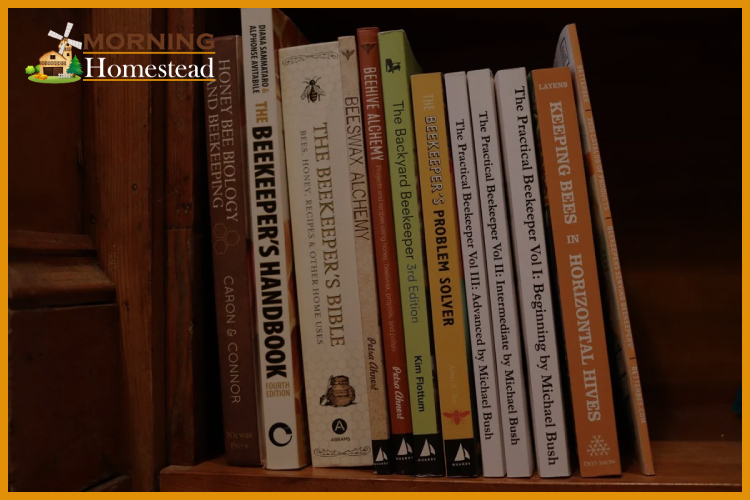Last Updated on June 9, 2023 by Georgie Smith
Guide to Bees and Honey
The crucial step of protecting bee colonies from parasites, diseases, and other harmful illnesses is the skill of identifying and handling the issues early. In this guide, you will learn all about the amazing honey bee and what delicious treat they create for themselves, and, luckily, us too.
Honey bees are majorly-important pollinators for fruits, vegetables, and flowers. That means that they assist with plants growing! Bees relocate pollen amongst the male and female parts, helping plants to grow fruit and seeds.
See Also:
| Best Honey Refractometer: 2023 Reviews (Top Picks) and Guide |
| Best Honey Extractor: 2019 Reviews and More Information on the Process of Honey |
| Best Bee Smoker: 2023 Reviews (Top Picks) and Guide |
Regular Honey Bee Development
Honey Bee
A healthy and strong honey bee colony has three precise types of individual bees: The queen bee, her workers, and the drones. Each kind of Bee has a different role in the colony. Together, they create the elements of a honey bee colony.
Honey bees live in colonies, often called hives. Let’s discuss the members of the colony and their duty.
- Queen: One queen manages the whole hive. She must lay the eggs that will brood the hive’s next generation of bees. The queen also harvests chemicals that influence the behavior of the other bees.
- Workers: The workers are all female, and they must scavenge for food (nectar or pollen from flowers), build and defend the hive, circulate and clean the air by thrashing their wings. Worker bees are the only bee people see flying around outside the colony.
- Drones: The drones are the male bees. Their sole purpose is to reproduce with the new queen. Several hundred exist in each colony during the summer and spring. But when winter arrives, the entire colony turns into survival mode; when this happens, the drones are all forced out!
What are these buzzing creatures most important job? Creating delicious honey! But, are you aware that they also harvest honey as food supplies for the colony during winter? Luckily for us, these productive little workers generate 2-3 times more honey than what they need, so in return, we get to relish the tasty treat, too!
If by chance the queen bee dies, the workers hussle to create a new queen by choosing a young larva. The young larva is a recently hatched baby insect. The workers feed the “chosen one” a unique food named the “royal jelly. “That jelly allows the larva to mature into a fertile queen.
Honey bees are fabulous flyers. They can fly at a whopping 15 miles per hour and pound their wings an impressive 200 times per minute. Each little bee has a massive 170 odorant receptors. What that means is that they have a powerful sense of smell. Haven’t you ever wondered how that tiny little insect finds pollen?
They utilize this sense to connect within the colony and to recognize different kinds of flowers when searching for food. The typical worker bee survives for only five to six weeks. During her time, she will produce an estimated twelfth of a teaspoon of delicious honey.
The queen can stay alive on average, five years. She is busiest during the hot summer months. At this time she will lay on average 2,500 eggs per day! Whoa!
Honey bees are brilliant little dancers! To distribute information that leads to food sources, they will perform whats called their ‘waggle dance.’ When each worker returns to the colony, she moves in a figure-of-eight shape and waggles its full body to specify the course of the food resource. Cool, huh?
On a sad note, over the last 15 years, hives of bees seem to disappear. To this date, the reason is unknown. Referred to as ‘colony collapse disorder,’ billions of honeybees across the globe are disserting their colonies. And, they never return. In some areas of the world, up to 90% have disappeared!
How Do I Know If I Will Be a Good Beekeeper?
Environmental considerations
Unless you reside on an iceberg or the Sahara Desert, more than likely you can keep bees. Bees are extraordinary creatures that function just fine in a wide array of environments. Beekeepers reside in tropical rain-forest, areas with long, hard-cold winters, and in almost every geographic scope in-between. If you have flowers blooming in your area of the globe, you can keep bees.
How about space? You won’t need much. Beekeepers in New York have one or two hives on their terraces or roof. Remember that bees travel miles and miles from the colony to gather pollen and nectar. They’ll scavenge an area as big as 6,000 acres, just doing their thing. So the only sector that you need for your bees is sufficient to house the colony itself.
Legal and Zoning restrictions Connected With Beekeeping
Most areas are quite accepting of beekeepers. But, a few may have local rules that ban beekeeping. Some may allow it but have restrictions on the number of colonies you can have. Some areas let you have bees but request that you register your colonies with the local government. Check with your local zoning board, state government, state agricultural, or town hall to find out what’s tolerable in your neighborhood.
Beekeeping equipment and costs
What will it cost to become a beekeeper? Beekeeping isn’t a costly hobby. You could invest around $200 to $400 for the equipment, beehive, medication, and tools. Also, you’d spend $60 to $80 for a bundle of bees and queen. These are one-time costs. Don’t forget, the possibility for a return on your investment. Your hive can provide you with up to 60 to 90 pounds of honey annually. At $6 to $8 a pound, (being a decent price for raw, all-natural honey) that should provide you an average income of $300 to $600 per colony!
How many beehives do you need?
Most beekeepers are beginning their journey with one hive. That’s typically an excellent way to start your first season. However, most beekeepers end up investing in a second colony in no time.
What kind of honey bees should you raise?
Honey bees that are most often raised by beekeepers in the U.S. are European in origin and carry the scientific name Apis mellifera.
Of the species, the most common bee is the “Italian” honey bee. These bees are hearty, docile, and efficient honey producers. They are an excellent choice for the new beginner beekeeper.
Time and commitment for beekeeping
Beekeeping is not a labor-intensive hobby or job. You may have to devote part of a weekend placing together your new paraphernalia. But the real-time that you utterly must spend with your bees is unexpectedly modest. After the first year, you should only need to go five to eight times to your beehives annually. By the time you devote to repairing equipment, harvesting honey, then clearing things away for a new season you may spend 35 to 40 hours annually. If you are/have made this a business, you may spend more time.
Beekeeper personality traits
If you take off running like mad when you see an insect, beekeeping may not be for you. However, if you love the outdoors, nature, and animals, and if you’re interested in how animals contribute and communicate to our environment, you’ll be fascinated by honey bees. If you like the conception of “farming” on a little scale, or you’re intrigued by the vision of harvesting your all-natural honey, you’ll appreciate being a beekeeper.
Allergies to Honey Bee Stings
If you’re going to turn into a beekeeper, you can assume that eventually you will get stung from time to time. It’s a fact of life. But, when you undertake responsible habits as a beekeeper, you will eliminate or at least minimize the odds that you’ll get stung.
All stings will hurt a little, but not for too long. Experiencing some swelling, itching, and redness is natural. These are standard (not allergic) reactions. Some people are somewhat allergic to bee stings, and the discomfort and swelling may be much more serious. The most life-threatening and severe reactions to the stings happen in less than 1 percent of the people. If you’re unsure, check with an allergist, who will establish whether you’re amongst the moderately few who ought to steer clear of beekeeping.
How To Get Started In Beekeeping
Get To Know About Bee’s
There are several books available to teach you all about beekeeping. The first step is to understand how these little insects can assist you in starting your hive off right the first time. Learn all you can learn about bees and be ready for when they arrive; This will be your best game plan for preparing yourself to be ready for when they arrive and on how to keep bees. Education is the key here for a successful adventure in harvesting.
Understand How Bee’s Make Honey
Before you rush in and begin ordering supplies, let’s take a step back and understand precisely how a colony works and what it is that bees do. Honey Bees build nests in Mother Nature, fly to blooms and take in the nectar. Next, they transport the nectar as they proceed to the comb and hive, where it gradually becomes honey.
Top 10 Best BEEKEEPING BOOKS On The Market
| Picture | Product Name | Pages |
|---|---|---|
 |
The Beekeeper’s Bible: Bees, Honey, Recipes & Other Home Uses | 416 pages |
 |
The Practical Beekeeper Volume I Beginning Beekeeping Naturally | 282 pages |
 |
An Absolute Beginner’s Guide to Keeping Bees in Your Yard and Garden | 208 pages |
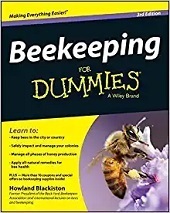 |
Beekeeping For Dummies | 456 pages |
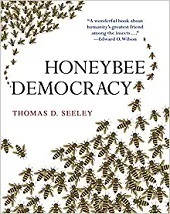 |
Honeybee Democracy | 280 pages |
 |
The Bee Book | 224 pages |
 |
The Beekeeper’s Problem Solver: 100 Common Problems Explored and Explained | 224 pages |
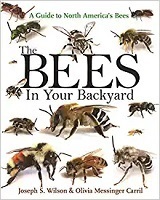 |
The Bees in Your Backyard: A Guide to North America‘s Bees | 288 pages |
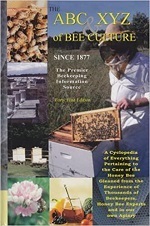 |
An Encyclopedia Pertaining to the Scientific and Practical Culture of Honey Bees | 911 pages |
 |
Beekeeping: A Personal Journey | 190 pages |
The Beekeeper’s Bible: HoneyBees, Honey, Recipes & Other Home Uses

Buy On Amazon
The Beekeeper’s Bible is as just as much a fundamental guide to the essential basics of beekeeping as it is a superb almanac you will want to read many times over. Part handbook, part cookbook, and part history book; this illustrated book covers every side of the ancient interest in beekeeping. Everything from how to operate hives safely to reaping one’s honey.
Fantastic ideas and details on how to use beeswax and honey. Detailed directions for making furniture polish, beauty products, candles, and around 100 honey-related recipes. Completely demonstrated with unique etchings and how-to photography. Every gardener or backyard fan can self-assuredly plunge into beekeeping with this tome in hand. Or dream about harvesting their honey while unwinding in the ease of a hammock.
The Practical Beekeeper: Volume One Beginning Beekeeping Naturally

Buy On Amazon
This book covers how to take care of bees in an efficient and natural process where treatments for diseases and pests take place with only minimum interventions. It is also about practical and straightforward beekeeping knowledge. It is about decreasing your work. It is not a mainstream beekeeping tome. Many of the ideas are different than ” standard ” beekeeping.
The procedures offered here are streamlined through years of adjustments, experiments, and simplification. The details were written and refined from answering questions on bee forums over decades and tailored to the queries that beekeepers, experienced and new, have. There are three volumes of this book, and this version encompasses only Volume One: Beginning Beekeeping Naturally.
Backyard Beekeeper:

Buy On Amazon
The Backyard Beekeeper, now modified and extended, makes the complicated and time-honored beekeeping an accessible and enjoyable backyard activity that will influence gardeners, cooks, and crafters, everywhere. This extended edition gives you, much more, data on “greening” your beekeeping with pesticide-resistant bees, urban and suburban, and natural practices in beekeeping. More than a handbook to beekeeping, it is a manual for reaping the goods of a beehive and a honey recipe book–all in one beautiful, dynamic, beautifully illustrated reference.
This complete honey bee resource contains thorough knowledge of bees; a how-to handbook to the skill of beekeeping and in what way to set up, tend to, and produce honey from your colonies. There is also a ton of bee-related projects and facts. You will discover the best area to find your new bee hives for your safety and theirs. You will study the leading nontoxic and organic techniques to tend to your bees.
That includes keeping them healthy with protection from the elements, proving fresh water, and all things necessary to keep them happy, healthy, and productive. Recipes for yummy treats and directions on how to utilize beeswax and honey to create beauty treatments and candles are all part of this delightful book.
Beekeeping For Dummies

Buy On Amazon
Want to know what the buzz is all about with beekeeping? The newest edition of Beekeeping For Dummies will provide you with the most up-to-date and trusted information on properly keeping your bees. That includes complete directions for assembling and sustaining beehives.
Also Included is information on all the newest tools and equipment needed for managing each phase of the production of honey and much more. If you are a seasoned beekeeper or searching for knowledge of backyard beekeeping, this book is for you. Or if all you need is knowledge of the latest techniques and tools, this friendly, hands-on guide is right for you.
Honeybee Democracy

Buy On Amazon
Honeybees make choices democratically and collectively. Each year, bees face the life-or-death obstacle of selecting and migrating to a new home. The bees bet all on a course that embraces consensus building, vigorous debate, and collective fact-finding.
In fact, as Thomas Seeley reveals, these marvelous insects have plenty to show us when it comes to shared wisdom and efficient decision-making. A richly illustrated and remarkable account of scientific finding, Honeybee Democracy provides, for the first time, years of Seeley’s ground-breaking research to communicate the remarkable story of house searching and democratic deliberation among the honeybees.
The Bee Book

Buy On Amazon
The Bee Book reveals to you in a step-by-step process how to get started in beekeeping, harness the power of honey for good health, and establish a bee-friendly garden. Thoroughly illustrated with full-color photos throughout, this lovely guide covers all you need to know to begin your backyard colony, from the begging setup to harvest. Applied beekeeping methods are explained with helpful diagrams and photos in step-by-step sequences so you can prepare to create your colony, collect a swarm, deal with diseases, and so much more.
An inclusive gardening chapter includes:
- Plans for planting to fill border gardens and containers.
- Bee habitat projects and “hotels.”
- A detailed gallery of the bees’ favorite flowers and plants.
The Bee Book instructs you on how to precisely harvest beeswax, honey, propolis, and beeswax from the hive and utilizes these three ingredients in 38 recipes for beauty treatments, candle making, and home remedies.
Learn the phenomenon of bees in the hive, in your garden, and in nature with The Bee Book. Beautifully bound in a stunning gold-foil and surface wrap making picture-perfect for gift giving.
The Beekeeper’s Problem Solver

Buy On Amazon
Beekeeping entails attention to detail, commitment, and understanding. Laying the groundwork for an efficient hive is crucial. It requires a vast appreciation of critical sections such as breed choice, health requirements, and colony management. Bees often mask problems, though, making identifying trouble in the core, initial phases that more challenging.
Whether you’re a veteran or a newcomer, The Beekeeper’s Problem Solver delivers the info you need to resolve these problems or evade them in the beginning. Author, Jeames E. Tew, an experienced beekeeper, and beehive expert, describes 100 common difficulties confronted by beekeepers. He distinctly reveals their leading cause, and how to resolve all of them. Each one is explained in depth, with diagrams and photographs as well as an extensive range of useful insights and practical tips. Don’t lose your colony to something unnecessary, just read your problem solver!
The Bees in Your Backyard

Buy On Amazon
The Bees in Your Backyard delivers an appealing summary of the roughly 4,000 diverse bee types found in Canada and the United States. The book dispels popular myths about bees while providing vital tips for identifying them in the field.
The book highlights more than 900 striking color photographs of the bees existing all around us―in our parks and gardens, in wild spaces, and along nature trails. It defines their unique history, counting where they exist, their role as pollinators, how to entice them to your backyard, and how they gather food. Ideal for experts and amateur naturalists. It provides detailed insight of every bee family and species in North America while unfolding key detection features, diets, nesting habits, distributions, and much more.
The ABC & XYZ of Bee Culture

Buy On Amazon
The ABC & XYZ Of Bee Culture book is the 41st edition and has more than 900 pages and over 1,000 photos. Most photographs are color, but several are black and white due to the vast array of historical topics, events, and people portrayed in the book and nowhere else. Created as a simple-to-use and thorough compilation of honey bees, successful beekeeping and beekeeping equipment, and practices.
The alphabetical lists cover completely all in the beekeeping realm. The 16-page Appendix is easy to use and includes hundreds of items to help with learning the art and science of beekeeping faster and simpler than what you could imagine. Nowhere else is there a further complete listing of the individuals and procedures that make up the account of keeping bees. Hundreds of people receive recognition for their influences to the beekeeping population
Beekeeping: A Personal Journey

Buy On Amazon
Books on beekeeping define how to achieve beekeeping duties. These books address mostly on the precise details of beekeeping. There are numerous beekeeping books available for reading. You could, with most, eliminate the title from one book and place it on another and not notice any changes.
When the author wrote this book, he wanted to incorporate the mechanical portions of beekeeping with the excitement beekeepers experience when mingling with their bees. The book is penned not just for the commercial beekeeper but for the hobby beekeeper as well. He shares his techniques with you as well as his philosophy on raising healthier and stronger bees without the use of any pesticides or chemicals or pesticides in the hive.
Tools You Need As A Beekeeper
Protective Gear
The first equipment purchase that a beekeeper must consider making is protective clothing. But some choose to go gear-free due to how the layers of the suit interfere with how they connect with their bees. It depends on how you plan to use the equipment and your personality. Luckily, there are numerous wardrobes options available to beekeepers. On one side of the protective gear spectrum, you have suits that cover the individual from head to toe.
However, such suits are more expensive. The average price is around $$, which includes everything necessary to cover every inch of the skin. Such as pants and jackets, (whether separate or jumper style), and a beekeeper veil. Coveralls that come without the veil are around $$.
The Smoker
Of all the major tools found in a beekeeper’s possession, the smoker is the most iconic and the most utilized. Smoke performs as a cushion to the honeybee’s secretion alarm system: When smoke is in a hive, it stops its capacity to connect inactive, temporarily calming the bees.
Without signals of danger scattering through the colony, the keeper can more quickly go through the responsibilities of frame removals, splits and honey extractions, and colony inspections. The smoker was designed from quality stainless steel with a firm chimney, bellows made of leather and wood, and metal guards to shield the beekeeper’s hands. Once lit, the smoke lightly floats out via a small hole at the top.

Buy On Amazon
The Hive Tool
While not severely required for inspections, some may argue that, without a beehive tool, examining some hives is almost unachievable. The tool is a flat, solid, metal tool. Typically, about ¼” thick, 2” wide, and 7” long. Hive tools have one elongated sharp end and one tapering curved end. Designed with lively colors, such as lemon yellow or bold red, they’re simple to locate in the bee yard.
The hive tool’s job is nearly never-ending; primarily, they assist the keeper with prying and eradicating frames thick with propolis. Affectionately identified by beekeepers as bee paste—that it is literally stuck in place. The hive tool can be utilized to cut open honeycomb, scrub away propolis, squash intruders like the hive beetles, and much more. Hive tools are a simple buy worth keeping around. A Hive tool typically costs around $.

Buy On Amazon
The Bee Brush
The bee brush is a soft-bristled brush for mildly removing bees from honey supers, frames, or other areas where they might be assembling in the beekeeper’s path. Of course, how soft a bee brush essentially can be is controlled by force exercised by the individual wielding it.
Some beekeepers have varied feelings about utilizing the bee brush with frequency; although the bristles are gentle, a blunt force brush can harm delicate and tiny bee parts, such as wings and legs. It could also frustrate and anger bees, leading to intensified alarm chemicals, increased incidence of stings, and a generally more traumatic beekeeping occurrence for both the bees and the humans. Other beekeepers believe the brush is necessary, in particular when it comes to honey extraction. With the low cost of around $, it won’t hurt to have one in your tool basket to find out if it works for you.
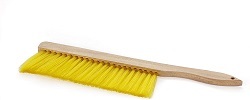
Buy On Amazon
Extracting Equipment
Whether electric or manual, commercial or small-scale, for the most part, extractors function the same way: Within their stainless-steel, large cylindrical bodies are many baskets that hold the honey frames. Centrifugal force, either electric or manual, forces the honey off the frames. The honey then drips down the interior walls toward a plug at the bottom. From here, the honey runs via a food-grade colander, then rests in bottling buckets for around 24 hours. Next, the honey goes into bottles, ready to eat!
Conclusion
As you can see, there is a broad knowledge foundation on beekeeping, including many periodicals and excellent books. Although the simple biology of honeybees is consistent, there are countless variables such as genetics, disease profiles, local crops, and weather and climate that unite to make beekeeping an intricate problem.
There are many different variants and methods for dealing with honeybee hives. Although, beekeepers incline to be independent and test their own methods.
If you have a desire to become a beekeeper, the ideal start is to educate yourself on all it takes to not only be successful but to be safe as well. There is a lot that humans can learn from the honeybees if we would only slow down long enough to realize, without the honeybee, many things taken for granted, would not exist.
So much of what humans take for granted derives from the work of the small bee. They are more than just makers of honey; they are extraordinary creatures that have natural instincts of protection, production, and structure.
Just the idea that one queen bee does all she does in an entire colony is fascinating alone. Mother Nature is the instructor and teacher to the honeybee. They clearly surpass humans in self-production and instruction.
Investing in honeybees is a wise choice. Hopefully, through this article, you have the knowledge to do so in a smart fashion. The suggested process of becoming a beekeeper is to read several books on the subject.
Perhaps it would even be wise to take some courses from an experienced beekeeping instructor that is in tune with your local region and area. Happy Beekeeping!
FAQs:
Q: Is there a known number of eggs the queen can lay in one day?
A: She will lay on average 2,500 eggs per day
Q: Can queen bees sting?
A: Can they? Sure. Will they? Very doubtful
Q: Why do I have dead bees in the front of my hive?
A: Due to the high number of eggs the queen lays as well as a short life-span of the bees, you will most likely always see dead bees.
Q: Why do honeybees mess up their combs?
A: Most of this is their genetics. Some bees build parallel straight combs no matter how hard you try or what you do.
Q: Burr comb?
A: The main reason of burr between the boxes is thin top bars.
Q; How many colonies should a beginner start with?
A: As mentioned in the article, it is wise, to begin with one.
Q: Which beekeeping book is the best?
A: every single one of them! Read them all.

